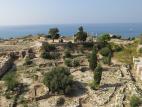
Byblos is reckoned to be one of the two or three oldest continuously-inhabited cities in the world (only Jericho is known to be older) and one of the best Phoenician archaeological sites. The Phoenicians invented alphabets: one of the most important innovations ever made. In a language which has an alphabet, a child can be taught to read in weeks, and almost everybody can be literate. In a language which does not - Chinese is a modern example - it takes several years to learn to read, and a significant fraction of the population never becomes literate. (Chinese educational authorities claim a literacy rate of 95% but that is because they have redefined "literacy" to mean "ability to recognise 1500 characters". To be able to read a simple Chinese newspaper, you need about 3000 characters. Here's a link.)
The Phoenicians flourished in Byblos, Sidon, and Tyre from about 2000BC until about 500BC, but their cities were conquered by the Persians, then Alexander, then the Romans, then the Arabs, then the Crusaders, then the Ottomans - most of whom knocked down the buildings they found to construct their own. Consequently, uncovering Phoenician buildings is a matter for archaeologists excavating layer by layer and deciding what to preserve in any given site. At Byblos, they chose the Phoenician remains, but all that's left in Byblos are some foundations, seen in the first photograph below, which was taken from a castle built by the Crusaders. Between the Phoenician foundations and the sea are some Roman remains.
Click on the pictures to enlarge.
More interesting is a Phoenician sarcophagus found at Byblos, dated to about 1200BC. It's actually in the National Museum of Beirut, where I took the photograph, but it seemed more appropriate to put the picture here.
Click on the next picture to see the detail of the inscription on the lid of the sarcophagus, which you can compare with the Wikipedia article which displays the Phoenician alphabet.